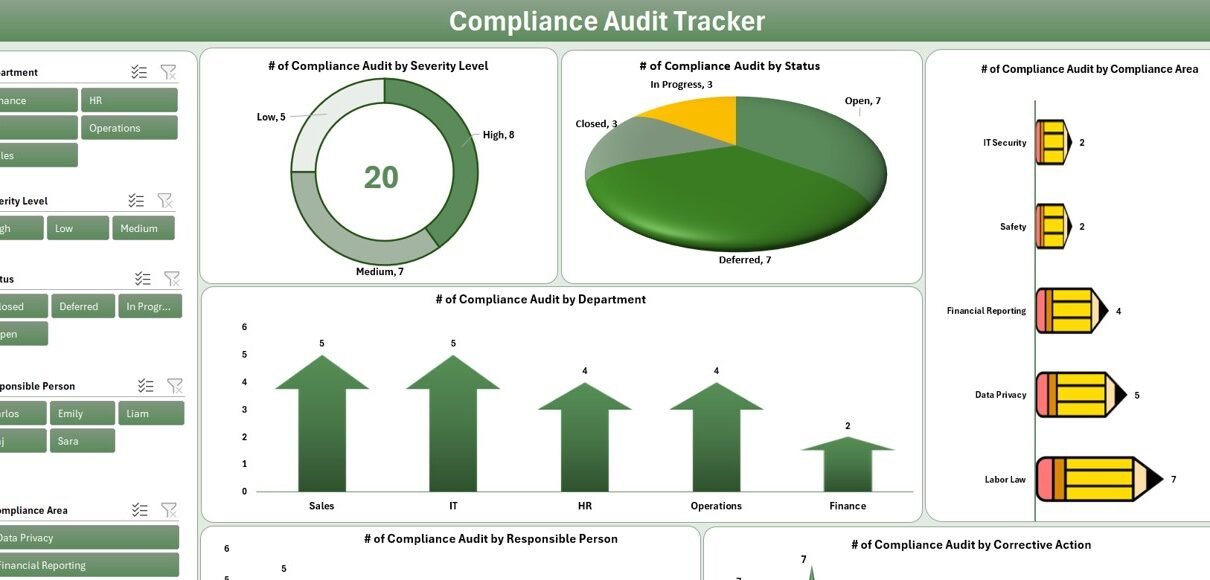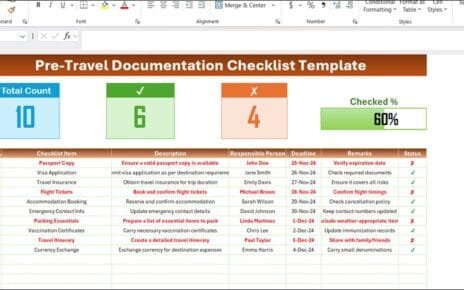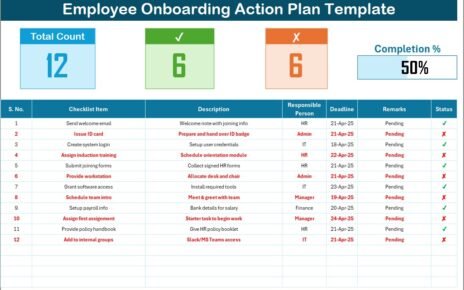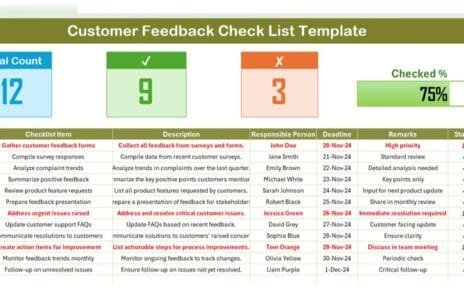In today’s fast-paced business environment, staying compliant with internal policies and external regulations is not just a best practice—it’s essential. Whether you’re managing audits for safety, quality, environment, or finance, tracking them manually can lead to missed deadlines and overlooked findings. That’s where the Compliance Audit Tracker in Excel steps in—a ready-to-use, interactive tool powered by Excel and VBA to simplify the entire audit tracking process.
This comprehensive article explores everything you need to know about the Compliance Audit Tracker in Excel, from its features to best practices, real-world benefits, and answers to frequently asked questions.
Click to Purchases Compliance Audit Tracker in Excel
What Is the Compliance Audit Tracker in Excel?
The Compliance Audit Tracker in Excel is a smart, Excel-based tool designed to help organizations track, manage, and review compliance audits effectively. It’s built using VBA (Visual Basic for Applications), allowing for automation of key actions such as data entry, dashboard visualization, record updates, and user management.
Unlike manual systems that require constant follow-ups, this tracker centralizes all audit-related information and presents it in a visually appealing dashboard. It’s suitable for quality assurance teams, internal auditors, compliance officers, and department managers across various industries.
Key Features of the Compliance Audit Tracker
Let’s explore the main components of this powerful tool that make it user-friendly, efficient, and customizable:
Login Form

Security matters. This tool includes a Login Form where users can enter a pre-set ID (e.g., Admin1) and password (e.g., abcd) to access the system. It restricts unauthorized usage and keeps your audit data safe.
Main Form

Once logged in, users land on the Main Form, a centralized control panel that lets you add, update, or delete audit records. It’s intuitive and eliminates the need to work directly with raw Excel tables.
Dashboard Sheet Tab

Click to Purchases Compliance Audit Tracker in Excel
This sheet offers a powerful visual summary of audit records with:
✅ 5 slicers for custom filtering
✅ 6 dynamic charts for instant insights:
- Doughnut Chart: Compliance Audits by Severity
- Pie Chart: Compliance Audits by Status
- Pencil Chart: Audits by Compliance Area
- Column Chart: Audits by Department
- Flag Chart: Audits by Responsible Person
- Column Chart: Audits by Corrective Action
These visuals update automatically as soon as you add, update, or delete records.
Data Entry Sheet Tab

The Data Entry Sheet holds your audit records in a structured table. Each entry includes:
-
ID
-
Department
-
Compliance Area
-
Auditor Name
-
Audit Date
-
Findings
-
Severity Level
-
Corrective Action
-
Responsible Person
-
Due Date
-
Status
-
Remarks
On top of the sheet, you’ll find:
➕ Add New Record button (opens a form to insert data)

🖊️ Update Record button (prefills form with selected record for editing)

❌ Delete Record button (with confirmation prompt)
Click to Purchases Compliance Audit Tracker in Excel
Manage List Sheet Tab

This sheet powers the dropdowns (combo boxes) in your data entry form. You can manage lists for:
-
Department
-
Compliance Area
-
Severity Level
-
Corrective Actions
-
Responsible Persons
-
Statuses
With the Add/Delete buttons, you can modify your categories as your business evolves.
Support Sheet Tab

This is a backend sheet used to power the pivot tables and charts on your dashboard. It works silently in the background—there’s no need to modify it.
User Management

Click the User Management button to:
-
Add new users
-
Update passwords
-
Delete user accounts
This feature ensures that multiple team members can access the system with appropriate login credentials.
Settings Sheet

Here, you can control basic tool settings and configurations. This sheet can also be expanded to include custom branding, deadline reminders, or workflow automation in the future.
Click to Purchases Compliance Audit Tracker in Excel
Advantages of Using the Compliance Audit Tracker in Excel
Let’s now break down why this tool is a game-changer for audit management:
✔️ Centralized Audit Information
All audit-related data—findings, actions, departments, and deadlines—reside in one place. No more scattered spreadsheets or emails.
✔️ Real-Time Visual Insights
Thanks to slicers and charts, managers can instantly view trends and performance gaps by severity, department, or responsible person.
✔️ User-Friendly Data Entry
The automated form simplifies data recording and reduces entry errors. Anyone, even with basic Excel knowledge, can use it.
✔️ Update and Delete with One Click
Editing or removing records is seamless. Select the record by ID, hit the button, and you’re done.
✔️ Custom Dropdown Management
You can manage categories from a single sheet. This keeps entries consistent and avoids typos.
✔️ Role-Based Access with Login
Access control ensures that only authorized users can view or edit data—ideal for large teams.
Best Practices for Using the Compliance Audit Tracker
To get the best out of this Excel tool, follow these simple best practices:
1. Always Use the Form for Data Entry
Avoid editing raw data in the sheet directly. The form ensures consistency, dropdown usage, and dashboard synchronization.
2. Keep the ‘Manage List’ Tab Updated
When adding new departments or compliance areas, update them in this tab. It keeps your dropdowns current.
3. Regularly Review the Dashboard
Use slicers to explore insights by time, severity, or team. Set a weekly or monthly review cycle.
4. Backup the File Weekly
Since this is an Excel file, store backup copies weekly to prevent data loss.
5. Train Your Team
Ensure everyone understands how to login, use the forms, and review charts. A 30-minute team session can boost tool adoption.
6. Customize As Needed
Want to add KPIs or set automated alerts? This Excel-VBA tool is fully customizable for advanced users.
Who Can Use This Tool?
This tracker is ideal for:
📌 Compliance Officers
📌 Internal Auditors
📌 Department Heads
📌 HR Teams
📌 IT Security Analysts
📌 Health and Safety Inspectors
📌 Quality Control Professionals
Whether you work in manufacturing, healthcare, finance, IT, or education, this tool adapts to your audit tracking needs.
Real-World Use Case Example
Let’s say your company conducts monthly internal audits across five departments. Using this tracker, the compliance officer can:
-
Log each audit with findings and severity
-
Assign responsible persons to corrective actions
-
Track status updates
-
Use dashboard visuals in management reports
-
Ensure no audit goes unresolved before deadlines
All within a single Excel file—no expensive software, no learning curve.
Additional Customization Ideas
To take your Compliance Audit Tracker to the next level, consider adding:
⏰ Email reminders for overdue audits
🔔 Conditional formatting to highlight critical issues
📎 File upload links (e.g., attach audit reports via hyperlinks)
📊 Charts by month or quarter to track trends
🏷️ Audit tags for better filtering (e.g., safety, IT, finance)
Conclusion
The Compliance Audit Tracker in Excel is more than just a spreadsheet—it’s a complete audit management solution. With built-in forms, dashboards, login controls, and editable dropdowns, this tool streamlines your compliance process while providing real-time insights.
If you’re tired of manual tracking or inconsistent records, it’s time to adopt this Excel-powered system. Save time, reduce risk, and bring clarity to your compliance workflow—without needing advanced software or IT support.
Frequently Asked Questions (FAQs)
1. Can I customize the Compliance Audit Tracker for my industry?
Yes, the tracker is fully customizable. You can add new fields, modify categories, or redesign the dashboard as per your requirements.
2. Do I need VBA knowledge to use this tool?
Not at all. The tool is ready to use. However, basic Excel knowledge is helpful. For advanced customizations, VBA knowledge is optional.
3. Is this tool secure for multiple users?
Yes. The built-in login system allows user-level access control. You can also manage and delete users securely.
4. Can I use this tool on Mac?
VBA features have limited support on Excel for Mac. It’s recommended to use this tracker on Windows with Excel 2016 or later for full functionality.
5. Can I track audit deadlines and overdue items?
Yes. You can view upcoming and past-due audits in the data sheet and create conditional formatting to highlight overdue tasks.
6. Is it possible to add new charts or filters?
Absolutely! You can create additional pivot tables and visuals in the dashboard using the support sheet.
7. How do I update a specific record?
Click the record’s ID in the data sheet, then click the Update Record button. The form will load with pre-filled values for editing.
8. Can this be used for both internal and external audits?
Yes. Simply add a column in the data table to specify the audit type (internal/external), and filter results accordingly in the dashboard.
Visit our YouTube channel to learn step-by-step video tutorials



